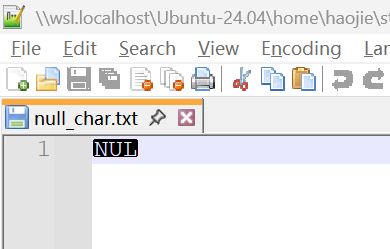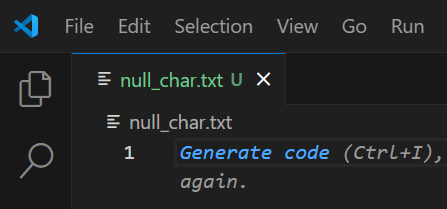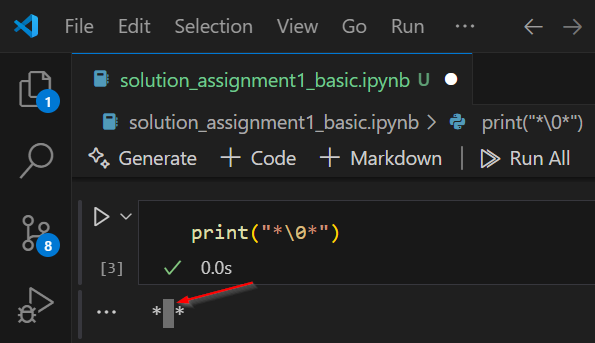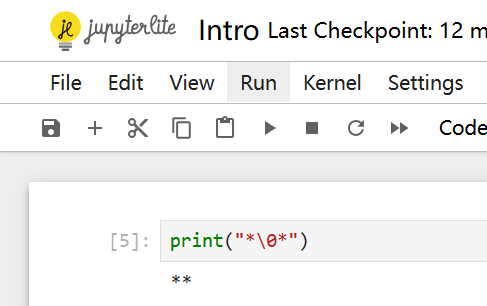The NULL character, often represented as \0, is a special character in programming that signifies the end of a string. It is widely used in various programming languages, including C, C++, Python, Go, and JavaScript. In this post, we will explore how the NULL character is represented and used in different programming languages, databases and editors.
Programming Languages
C and C++
#include <stdio.h>
#include <string.h>
int main() {
char str[] = "Hello, World!\0This part is ignored.";
printf("String: %s\n", str); // Output: Hello, World!
printf("Length: %zu\n", strlen(str)); // Output: 13
return 0;
}
Because it’s origins are in C, we start with C and C++.
In C and C++, the NULL character is represented as '\0'. It is used to terminate strings, which are essentially arrays of characters. The presence of the NULL character indicates the end of the string, allowing functions like strlen and printf to determine where the string ends.
You can run the following example by yourself with this link: C_Null_Char
In this example, the string str contains a NULL character after “Hello, World!”. When printed, only the part before the NULL character is displayed. When calculating the length of the string using strlen, it returns 13, which is the length of “Hello, World!” excluding the NULL character and anything that follows it.
Python
# Example of NULL character in Python
s = "Hello, World!\0This part is ignored."
print("String:", s) # Output: Hello, World!This part is ignored.
print("Length:", len(s)) # Output: 35
assert chr(0) == "\0"
In Python, the NULL character is represented as '\0'. You can also obtain this character using the chr function. Python strings are not null-terminated, but you can include the NULL character in a string. It is often used in binary data or when interfacing with C libraries. You can try the following code with this link: Python_Null_Char
JavaScript
// Example of NULL character in JavaScript
let str = "Hello, World!\0This part is ignored.";
console.log("String:", str); // Output: Hello, World!This part is ignored.
console.log("Length:", str.length); // Output: 35
In JavaScript, the NULL character is represented as '\0'. JavaScript strings are not null-terminated, but you can include the NULL character in a string. You can try the following code with this link: JavaScript_Null_Char
Go
package main
import (
"fmt"
)
func main() {
str := "Hello, World!\x00This part is ignored."
fmt.Println("String:", str) // Output: Hello, World!This part is ignored.
fmt.Println("Length:", len(str)) // Output: 35
}
In Go, the NULL character is represented as '\0', but it is not commonly used. Go strings are not null-terminated; they are represented as a sequence of bytes with a length. However, you can still use the NULL character within strings.
SQL Databases
The null character can also be used in SQL queries, although its behavior may vary depending on the database system.
PostgreSQL
SELECT chr(0) AS result;
-- Error: null character not permitted
Running the above query in PostgreSQL 16.6 will throw an error because PostgreSQL does not permit null characters in strings.
MySQL
SELECT
'Hello, World!' || CHAR(0) || 'This part is ignored.' AS null_in_string,
CONCAT('Hello, World!', CHAR(0), 'This part is ignored.') AS null_concacted,
CHAR(0) AS null_only;
-- Output:
-- +----------------+--------------------------------------------------------------------------+----------------------+
-- | null_in_string | null_concacted | null_only |
-- +----------------+--------------------------------------------------------------------------+----------------------+
-- | 0 | 0x48656C6C6F2C20576F726C6421005468697320706172742069732069676E6F7265642E | 0x00 |
-- +----------------+--------------------------------------------------------------------------+----------------------+
Due to my limited SQL knowledge, the behavior of NULL characters in MySQL seems weird. Therefore, I asked ChatGPT to help me with this:
- The
||operator in MySQL is not used for string concatenation; instead, it is a logical OR operator. To concatenate strings in MySQL, you should use theCONCATfunction. When you use'Hello, World!' || CHAR(0) || 'This part is ignored.', MySQL evaluates the logical OR.CHAR(0)is treated as0, which is considered false in a boolean context. Therefore, the expression evaluates to'Hello, World!', and the rest is ignored. - Using the
CONCATfunction withCHAR(0)results in a binary string becauseCHAR(0)introduces a binary context. This is what I see in MySQL 9.4.0 console. In some online MySQL playground, you may see the output as string withnullreplaced by a
- 48656C6C6F2C20576F726C6421 = “Hello, World!”
- 00 = NULL character
- 5468697320706172742069732069676E6F7265642E = “This part is ignored.”
- Selecting
CHAR(0)alone returns a binary string representation of the NULL character, which is displayed as0x00in hexadecimal format.
BigQuery
SELECT
'Hello, World!' || CHR(0) || 'This part is ignored.' AS null_in_string,
CONCAT('Hello, World!', CHR(0), 'This part is ignored.') AS null_concacted,
CHR(0) AS null_only;
-- Output:
-- +-----------------------------------+-------------------------------------+-----------+
-- | null_in_string | null_concacted | null_only |
-- +-----------------------------------+------------------------------------+-----------+
-- |Hello, World!This part is ignored. | Hello, World!This part is ignored. | |
-- +-----------------------------------+-------------------------------------+-----------+
In BigQuery, the NULL character is allowed in strings, and it behaves similarly to other programings such as Go and Python. You can use the CHR function to represent the NULL character but it won’t show anything in the terminal console or web UI.
Editors
Most modern text editors and IDEs can handle NULL characters, but their behavior may vary. Some editors may display the NULL character as a special symbol (like ␀), while others may ignore it or replace it with a space. It’s important to be cautious when editing files that contain NULL characters, as they can affect how the file is interpreted by different programs.
NotePad++
In my oppinion, Notepad++ is the best text editor to handle NULL characters. It displays the NULL character as NUL and allows you to see and edit it directly.

VSCode - Text File
In VSCode, the NULL character is not displayed. A text file containing NULL characters will be shown as an empty file.

VSCode - Notebook
Print the NULL character in a VSCode notebook will show an empty space, which is very misleading.

Jupyter Notebook
Compared to VSCode notebook, Jupyter Notebook handles NULL characters better. It does not show anything.

Vim
In Vim, the NULL character is displayed as ^@. You can see and edit it directly in the editor.

Summary
Below are the tables summarizing the representation and behavior of the NULL character in different programming languages and SQL databases, as well as text editors.
| Language | Representation | Behavior/Notes |
|---|---|---|
| C/C++ | "\0" |
ℹ️ Used to terminate strings. Functions like strlen and printf rely on it to determine string length. |
| Python | "\0" or chr(0) |
Allowed in strings but not shown. |
| JavaScript | "\0" |
Allowed in strings but not shown. |
| Go | "\x00" |
Allowed in strings but not shown. |
| Database | Representation | Behavior/Notes |
|---|---|---|
| PostgreSQL | CHR(0) |
🚨 Not permitted in strings; will throw an error if used. |
| MySQL | CHAR(0) |
Treated as an binary string. |
| BigQuery | CHR(0) |
Allowed in strings but not shown. |
| Editor | Representation | Behavior/Notes |
|---|---|---|
| VSCode (Notebook) | |
⚠️ Appears as empty space. |
| Notepad++ | NUL |
Displayed as NUL. |
| Vim | ^@ |
Displayed as ^@. |
| VSCode (Text File) | Not displayed | |
| Jupyter Notebook | Not displayed |